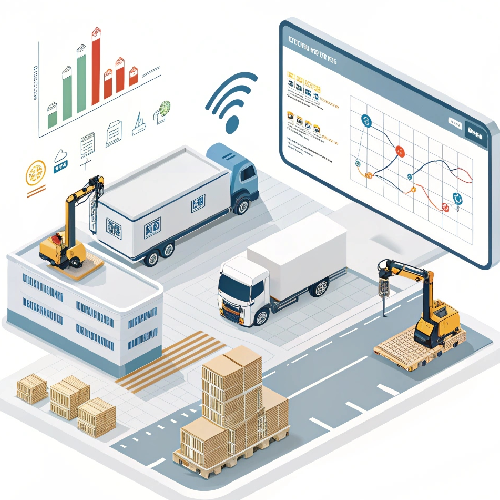Why Traditional Logistics Is No Longer Enough
In today’s supply chain landscape, businesses face mounting challenges: rising delivery costs, inefficient inventory management, and a lack of real-time visibility. E-commerce logistics solutions struggle to keep up with demand fluctuations, while vehicle logistics solutions often lead to high fuel expenses due to suboptimal routing.
To address these inefficiencies, many companies are turning to AI solutions for logistics, cloud-based logistics solutions, and customised logistics solutions to streamline operations, enhance tracking, and cut costs. But how do these solutions work in practice, and which approach is best suited for your business?
The Biggest Logistics Problems and AI-Driven Solutions
1. High Delivery Costs Due to Poor Route Planning
One of the biggest cost drivers in logistics is last-mile delivery. Inefficient routing increases fuel consumption, extends delivery times, and creates unnecessary fleet wear and tear.
A Smarter Approach: AI-powered route optimization tools analyze live traffic conditions, weather forecasts, and vehicle load capacity to dynamically adjust delivery paths. Businesses implementing smart logistics solutions have reported a 20% reduction in fuel costs simply by optimizing delivery schedules.
Among AI tools that help with dynamic route planning, Onfleet and Route4Me are widely used for optimizing delivery times and reducing mileage.
2. Inefficient Inventory Management and Overstocking
Warehouses often struggle with visibility into stock levels, leading to either over-purchasing or running out of essential products. Manual tracking methods can be unreliable, especially as businesses scale.
How to Fix It: Many businesses are adopting cloud-based logistics solutions that provide real-time stock monitoring and automated inventory updates. This helps minimize human errors, improve forecasting accuracy, and prevent unnecessary storage costs. By integrating cloud-based systems with AI logistics solutions, some companies have reduced waste and improved order fulfillment efficiency by up to 30%.
An example of AI-driven inventory management is NetSuite WMS, which helps businesses automate stock control and improve warehouse efficiency.
3. Supply Chain Disruptions and Lack of Real-Time Visibility
Unexpected disruptions—such as supplier delays, congested shipping routes, or last-minute cancellations—can create costly bottlenecks in logistics operations. Without clear tracking, businesses risk losing revenue due to shipment delays and inventory mismanagement.
Enhancing Visibility with Smart Tracking: Companies that integrate AI logistics solutions with IoT tracking devices gain real-time insights into their shipments. By leveraging predictive analytics, businesses can anticipate delays and proactively reroute deliveries to maintain supply chain stability.
For example, FourKites and Project44 use AI-powered tracking to provide full supply chain visibility, alerting businesses to disruptions before they escalate.
4. The Challenge of One-Size-Fits-All Logistics Solutions
Not all businesses have the same logistics requirements. A company shipping perishable goods has vastly different needs than one transporting industrial machinery.
Why a Custom Approach Works: Many organizations are shifting toward customised logistics solutions that cater to industry-specific challenges. For example, businesses managing fragile shipments now use automated packaging adjustments and climate-controlled transport monitoring to reduce damage risks.
Companies like Flexport and Blue Yonder offer AI-driven logistics customization, helping businesses fine-tune their supply chain strategies based on industry-specific needs.
How to Implement AI and Cloud-Based Logistics Solutions in Your Business
For companies looking to integrate these technologies, the key is to start small and scale up. Here’s how:
- Assess Your Current Logistics Challenges: Identify weak points in your supply chain—whether it’s excessive fuel costs, inventory mismanagement, or delivery inefficiencies.
- Select the Right Approach: Businesses focusing on fleet optimization may benefit most from AI-driven vehicle logistics solutions, while those struggling with warehouse inefficiencies might prioritize cloud-based logistics solutions.
- Leverage Automation for Smarter Decision-Making: AI-powered analytics help logistics managers anticipate demand fluctuations, adjust routing in real time, and improve warehouse stocking strategies.
- Monitor and Optimize Continuously: A logistics strategy should evolve alongside technology advancements. Businesses that regularly analyze performance metrics and refine their smart logistics solutions tend to see sustained cost savings and efficiency improvements.
Final Thoughts: The Future of AI in Logistics
With logistics costs rising and supply chains becoming more complex, businesses need adaptive, data-driven solutions to stay competitive. The integration of AI solutions for logistics, cloud-based logistics solutions, and customised logistics solutions is no longer optional—it’s becoming essential for long-term success.
Companies that invest in smart logistics solutions today will not only cut operational costs but also gain a competitive edge through greater efficiency, transparency, and adaptability.
What’s Next? Start assessing your logistics needs and explore AI-driven automation to optimize your supply chain today.

